CBSE Class 12 Physics Chapter 9 Ray Optics and Optical notes in PDF are available for free download in myCBSEguide mobile app. The best app for CBSE students now provides Ray Optics and Optical class 12 Notes latest chapter wise notes for quick preparation of CBSE board exams and school-based annual examinations. Class 12 Physics notes on chapter 9 Ray Optics and Optical are also available for download in CBSE Guide website.
CBSE Guide Ray Optics and Optical class 12 Notes
CBSE guide notes are the comprehensive notes which covers the latest syllabus of CBSE and NCERT. It includes all the topics given in NCERT class 12 Physics textbook. Users can download CBSE guide quick revision notes from myCBSEguide mobile app and my CBSE guide website.
Class 12 Physics notes Chapter 9 Ray Optics and Optical
Download CBSE class 12th revision notes for chapter 9 Ray Optics and Optical in PDF format for free. Download revision notes for Ray Optics and Optical class 12 Notes and score high in exams. These are the Ray Optics and Optical class 12 Notes prepared by team of expert teachers. The revision notes help you revise the whole chapter 9 in minutes. Revision notes in exam days is one of the best tips recommended by teachers during exam days.
Download Revision Notes as PDF
CBSE Class 12 Physics Revision Notes Chapter 9 Ray Optics and Optical Instruments
- Reflection: When light is incident on a surface, it is sent back by the surface in the same medium through which it had come. This phenomenon is called ‘reflection of light’ by the surface.
- Laws of Reflection: The reflection at a plane surface always takes place in accordance with the following two laws:
(i) The incident ray, the reflected ray and normal to surface at the point of incidence all lie in the same plane.
(ii) The angle of incidence i is equal to the angle of reflection r, i. e.,
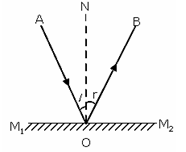
- Formation of Image by the Plane Mirror: The formation of image of a point object O by a plane mirror is represented in figure.
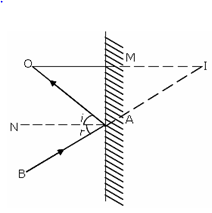 “
“
The image formed I has the following characteristics:-
(i) The size of image is equal to the size of object.
(ii) The object distance = Image distance i.e., OM = MI.
(iii) The image is virtual and erect.
(iv) When a mirror is rotated through a certain angle, the reflected ray is rotated through twice this angle.
Reflection of Light from Spherical Mirror:
a) A spherical mirror is a part cut from a hollow sphere.
b) They are generally constructed from glass.
c) The reflection at spherical mirror also takes place in accordance with the laws of reflection.
- Sign Convention: Following sign conventions are the new cartesian sign convention:-
(i) All distances are measured from the pole of the mirror & the distances measured in the direction of the incident light is taken as positive. In other words, the distances measured toward the right of the origin are positive.
(ii) The distance measured against the direction of the incident light are taken as negative. In other words, the distances measured towards the left of origin are taken as negative.
(iii) The distance measured in the upward direction, perpendicular to the principal axis of the mirror, are taken as positive & the distances measured in the downward direction are taken as negative.
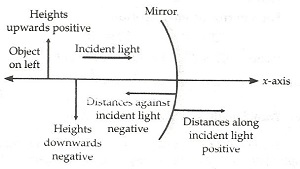
- Focal Length of a Spherical Mirror:
a) The distance between the focus and the pole of the mirror is called focal length of the mirror and is represented by f.
b) The focal length of a concave mirror is negative and that of a convex mirror is positive.
c) The focal length of a mirror (concave or convex) is equal to half of the radius of curvature of the mirror, i.e., f = . - Principal Axis of the Mirror: The straight line joining the pole and the centre of curvature of spherical mirror extended on both sides is called principal axis of the mirror.
- Mirror Formula:
Where u = distance of the object from the pole of mirror
v = distance of the image from the pole of mirror
f = focal length of the mirror
Where R is the radius of curvature of the mirror. - Magnification: It is defined as the ratio of the size of the image to that of the object.
Linear magnification,
Where I = size of image and O = size of obje - Magnification, m is positive, implies that the image is real and inverted.
- Magnification, m is negative, implies that the image is virtual and erect.
Image formation by a concave mirror:-
| S.No. | Position of object | Position of image | Nature of image | Size of image |
| 1 | Infinity | At F | Real and inverted | Highly diminished |
| 2 | Beyond C | Between F & C | Real and inverted | Diminished |
| 3 | At C | At C | Real and inverted | Same size |
| 4 | Between C & F | Beyond C | Real and inverted | Magnified |
| 5 | At F | At infinity | Real and inverted | Highly magnified |
| 6 | Between F & P | Behind the mirror | Virtual & erect | Magnified |
Image formation by a convex mirror:-
| S.No. | Position of object | Position of image | Nature of image | Size of image |
| 1 | Infinity | At F | Virtual & erect | Highly diminished |
| 2 | Between and P | Between P and F | Virtual & erect | Diminished |
- Refraction: The phenomenon of the change in the path of light as it passes obliquely from one transparent medium to another is called refraction of light.
- Laws of Refraction:
(i) The incident ray, normal at the point of incidence and refracted ray all lies in the same plane.
(ii) For the same pair of media and the same colour of light, the ratio of the sine of the angle of incidence to the sine of the angle of refraction is constant i.e.,
Where is a constant known as Refractive Index of the medium b with respect to the medium a, i is the angle of incidence in medium a and r is the angle of refraction in medium b. - Refractive index:- It is defined as the ratio of the speed of light in vacuum to its speed in that medium.
- Principle of Reversibility of Light: As light follows a reversible path,
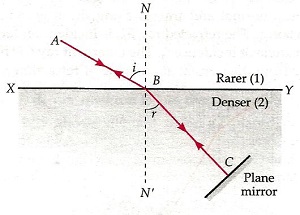
Multiplying we get, - Methods to Determine Refractive Index of a Medium: Refractive index of a medium can also be determined from the following:
(i)
(ii)
Where c is the critical angle. - Critical Angle: The Critical angle is the angle of incidence in a denser medium corresponding to which the refracted ray just grazes the surface of separation.
- Total internal reflection: The phenomenon in which a ray of light travelling at an abgle of incidence greater than the critical angle from denser to a rarer medium is totally reflected back into the denser medium is called total internal reflection.

- Apparent Depth of a Liquid: If the object be placed at the bottom of a transparent medium, say water, and viewed from above, it will appear higher than it actually is.
The refractive index in this case is:
Refractive index of the medium, = - Normal shift: The height through which an object appears to be raised in a denser medium is called normal shift.
- Refraction through a Single Surface: If are refractive indices of rare and denser media respectively, R is the radius of curvature of spherical surface.
When object is in rare medium:
When object is in denser medium:
where u and v are the distances of the object and the image from the centre of the refracting surface of radius of curvature R respectively. - Refraction through a Thin Lens (Lens maker’s formula): If R1 and R2 are radii of curvature of first and second refracting surfaces of a thin lens of focal length f, then lens-makers formula is
If the lens is surrounded by air, and , then
Image formation by a convex lens:-
| S.No. | Position of object | Position of image | Nature of image | Size of image |
| 1 | Infinity | At F | Real and inverted | Highly diminished |
| 2 | Beyond 2F | Between F & 2F | Real and inverted | Diminished |
| 3 | At 2F | At 2F | Real and inverted | Same size |
| 4 | Between 2F & F | Beyond 2F | Real and inverted | Magnified |
| 5 | At F | At infinity | Real and inverted | Highly magnified |
| 6 | Between F & O | Same side | Virtual & erect | Magnified |
Image formation by a concave lens:-
| S.No. | Position of object | Position of image | Nature of image | Size of image |
| 1 | Infinity | At F | Virtual & erect | Highly diminished |
| 2 | Between and O | Same side | Virtual & erect | Diminished |
- Thin lens formula:
- Magnification Produced by a Lens:
Where I is the size of image and O is the size of object.
- Power of a Lens: The power of a lens P is its ability to deviate the ray towards axis.
- Focal Length of Thin Lenses: The focal length () of thin lenses of focal lengths placed in contact of each other is
- Refraction Through Prism: When a ray of monochromatic light is refracted by a prism, the deviation produced by the prism is
Where i = angle of incidence
e = angle of emergence
A = angle of the prism
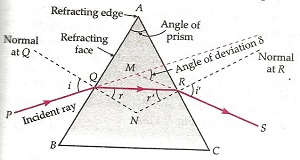
- Angle of Deviation: The minimum value of the angle of deviation suffered by a ray on passing through a prism is called the angle of minimum deviation and is denoted by .

- Dispersion: The splitting of white light into constituent colours is called the dispersion of light. A prism causes deviation as well as dispersion.
- The pattern of the coloured bands obtained on the screen is called spectrum.

- Angular dispersion: The angular seperation between the two extreme colours (violet and red) in the spectrum is called the angular dispersion.
- Dispersive Power: It is defined as the ratio of the angular dispersion to the mean deviation.
- Optical Instruments: Optical instruments are the devices which help human eye in observing highly magnified images of tiny objects, for detailed examination and in observing very far objects whether terrestrial or astronomical.
- Human Eye:
a) It is the most familiar and complicated optical instrument provided by nature to living beings. In this device, light enters through a curved front surface, called cornea, passes through the pupil – central hole in the iris.
b) The light is focused by the eye lens on the retina.
c) The retina senses light intensity and colour and transmits the electrical signals via optical nerves to the brain.
d) Brain finally processes the information. - Accomodation of human eye: It is the ability of the eye lens due to which it can change its focal length so that images of objects at various distances can be formed on the same retina.
- Microscope:
a) A simple microscope is a short focal length convex lens.
b) The magnifying power of a simple microscope is
c) The magnifying power, M of a compound microscope when final image is formed at least distance of distinct vision- & when image is formed at infinity-
Where Mo and Me denotes the linear magnification of the objective and eye lens. - Telescope: It is an optical device which enables us to see distant objects clearly.
a) The magnifying power, M of refracting telescope is , Where L is the length of the telescope.
b) For the final image is formed at the least distance of distant vision, the magnifying power is
c) The resolving power of a telescope
Where, = wavelength of light, θ = angle subtended by then point object at the objective and d = diameter of the objective of the telescope.
- Reflecting telescopes:-
- Newtonian type-

- Cassegrain type-
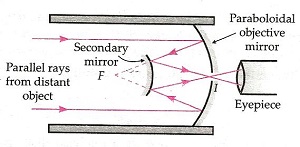
Ray Optics and Optical class 12 Notes
- CBSE Revision notes (PDF Download) Free
- CBSE Revision notes for Class 12 Physics PDF
- CBSE Revision notes Class 12 Physics – CBSE
- CBSE Revisions notes and Key Points Class 12 Physics
- Summary of the NCERT books all chapters in Physics class 12
- Short notes for CBSE class 12th Physics
- Key notes and chapter summary of Physics class 12
- Quick revision notes for CBSE board exams
CBSE Class 12 Revision Notes and Key Points
Ray Optics and Optical class 12 Notes. CBSE quick revision note for class-12 Physics, Chemistry, Math’s, Biology and other subject are very helpful to revise the whole syllabus during exam days. The revision notes covers all important formulas and concepts given in the chapter. Even if you wish to have an overview of a chapter, quick revision notes are here to do if for you. These notes will certainly save your time during stressful exam days.
- Physics
- Chemistry
- Mathematics
- Biology
- Accountancy
- Economics
- Business Studies
- Computer Science
- Informatics Practices
- English Core
- History
- Physical Education
To download Ray Optics and Optical class 12 Notes, sample paper for class 12 Physics, Chemistry, Biology, History, Political Science, Economics, Geography, Computer Science, Home Science, Accountancy, Business Studies, and Home Science; do check myCBSEguide app or website. myCBSEguide provides sample papers with solution, test papers for chapter-wise practice, NCERT solutions, NCERT Exemplar solutions, quick revision notes for ready reference, CBSE guess papers and CBSE important question papers. Sample Paper all are made available through the best app for CBSE students and myCBSEguide website.
- Electric Charges and Fields class 12 Notes Physics
- Electrostatic Potential and Capacitance class 12 Notes Physics
- Current Electricity class 12 Notes Physics
- Moving Charges and Magnetism class 12 Notes Physics
- Magnetism and Matter class 12 Notes Physics
- Electromagnetic Induction class 12 Notes Physics
- Alternating Current class 12 Notes Physics
- Electromagnetic Waves class 12 Notes Physics
- Ray Optics and Optical class 12 Notes Physics
- Wave Optics class 12 Notes Physics
- Dual Nature of Radiation and Matter class 12 Notes Physics
- Atoms class 12 Notes Physics
- Nuclei class 12 Notes Physics
- Electronic Devices class 12 Notes Physics
- Communication Systems class 12 Notes Physics

Test Generator
Create question paper PDF and online tests with your own name & logo in minutes.
Create Now
Learn8 App
Practice unlimited questions for Entrance tests & government job exams at ₹99 only
Install Now